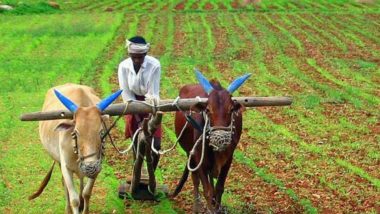London, October 21: Water experts at the UK's University of Birmingham say they have designed a low-energy and high-efficiency means of purifying water for India's rural farming communities, which could allow farmers to safely use high-saline groundwater and wastewater to grow crops.
Working in Gujarat, scientists in the Birmingham-led India-H2O project have used emerging membrane technologies that allow saline groundwater and domestic/industrial wastewaters to be safely and efficiently recycled. Also Read | ‘Pakistan Army Should Stop Interfering or There Will Be No Unity in the Country’, Says Jamiat Ulema-e Islam (F) Chief Fazlur Rehman.
Based on field work in the village of Lodhwa, which confirmed the poor quality and availability of water in the region, scientists believe they have now designed a system that can recover 80 per cent of the unusable groundwater fed into it – producing usable water with low energy consumption.
“India-H2O is developing, designing and demonstrating low-cost water treatment systems for saline groundwater and for domestic and industrial wastewaters in Gujarat, where over-extraction and pollution of groundwater makes it more and more difficult to access clean water,” said Philip Davies, Professor of Water Technology at the University of Birmingham. Also Read | Pakistan Warns of New Lockdown as COVID-19 Mortality Rate Increases by 140%.
“Combining novel engineering solutions with new reverse- and forward-osmosis membrane technologies should substantially reduce energy consumption – allowing efficient operation of these systems in rural India using solar energy. They should increase the amount of drinking water extracted from groundwater by 50 per cent,” he said.
His team is also developing ways of growing special crops using the brine solution produced as a result of desalination, as well as progressing plant-based treatments to recycle domestic wastewater and developing solar-energy to break down pollutants in industrial wastewater.
The new technology should enable cultivation of halophytic crops – salt-tolerant plants usually found in areas such as in saline semi-deserts, mangrove swamps, marshes and sloughs and seashores. Some of these species are high yield and nutritious, with important potential to supplement diet, the university said.
“Novel use of halophytic plants in an integrated water management system to eliminate harmful brine discharges and produce commercial crops will represent significant progress in water management in India. Such crops are rarely commercialised in India and little is known about the native species and their potential for use with desalination brines,” added Prof. Davies.
Groundwater is the major source of water across India, with 85 per cent of the population dependent on it. Much of this groundwater, however, is of poor quality and water below 60 per cent of India's countryside is too saline for human consumption or conventional agriculture. Over-extraction and pollution of groundwater are also making it more difficult to access clean water.
Over the next decade, the number of people affected by severe water shortages is expected to increase fourfold. Of the 2,700 billion m3 hike in water demand forecast for 2030, some 468 billion m3 (17 per cent) is expected to occur in India.
Desalination of brackish water and recycling of wastewater hold potential to fill the widening gap, but the cost of energy and the investment in equipment required for desalination and recycling has limited implementation of these technologies so far, the university experts note.
The India-H2O consortium comprises 18 participating organisations from across the European Union (EU) and India, including universities, research institutes, industries and NGOs.
Consortium members have been working in teams, each dedicated to a specific work package – for example groundwater desalination, phytoremediation, industrial systems, control systems, water governance, and business development.
(The above story is verified and authored by Press Trust of India (PTI) staff. PTI, India’s premier news agency, employs more than 400 journalists and 500 stringers to cover almost every district and small town in India.. The views appearing in the above post do not reflect the opinions of LatestLY)













 Quickly
Quickly


